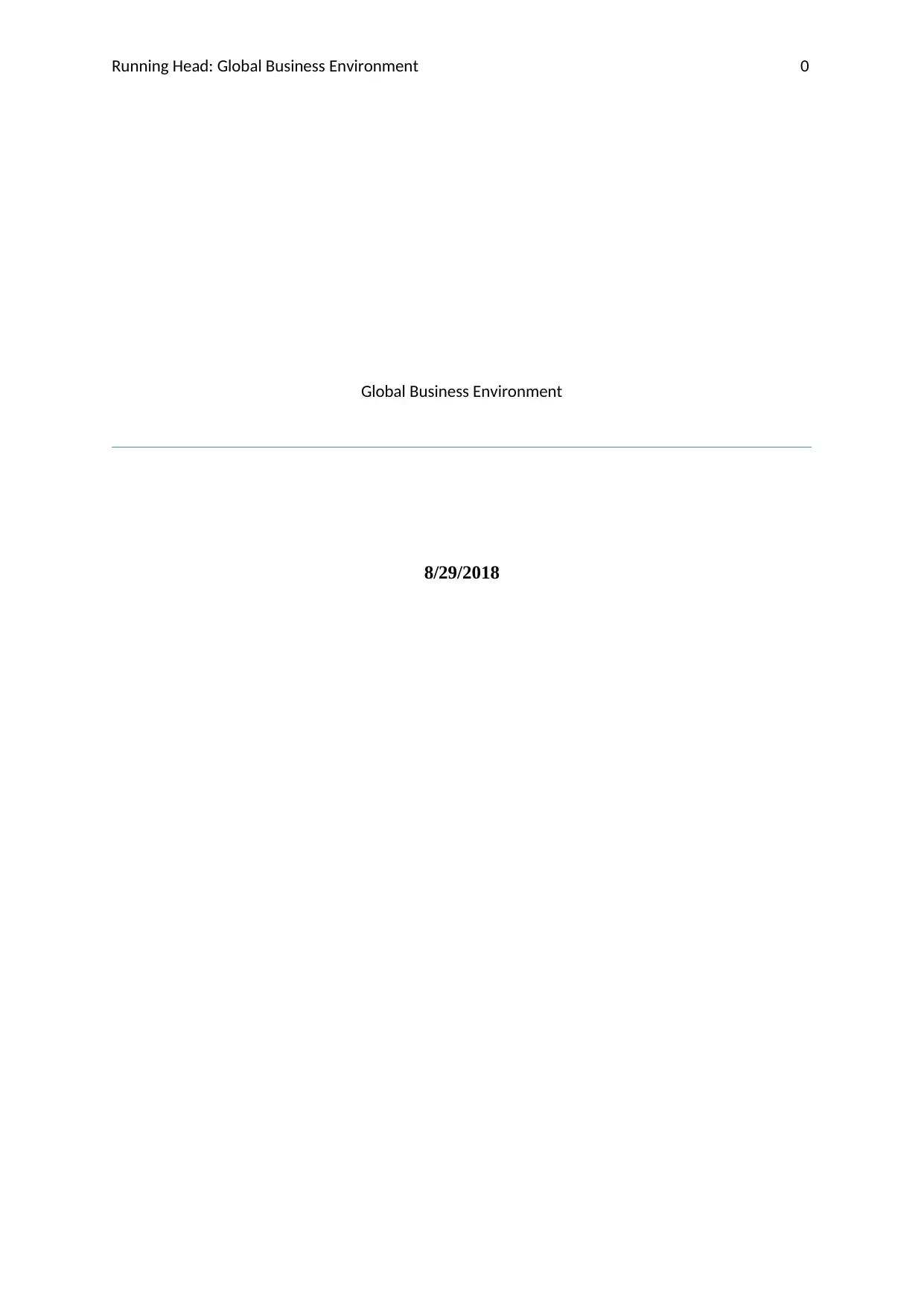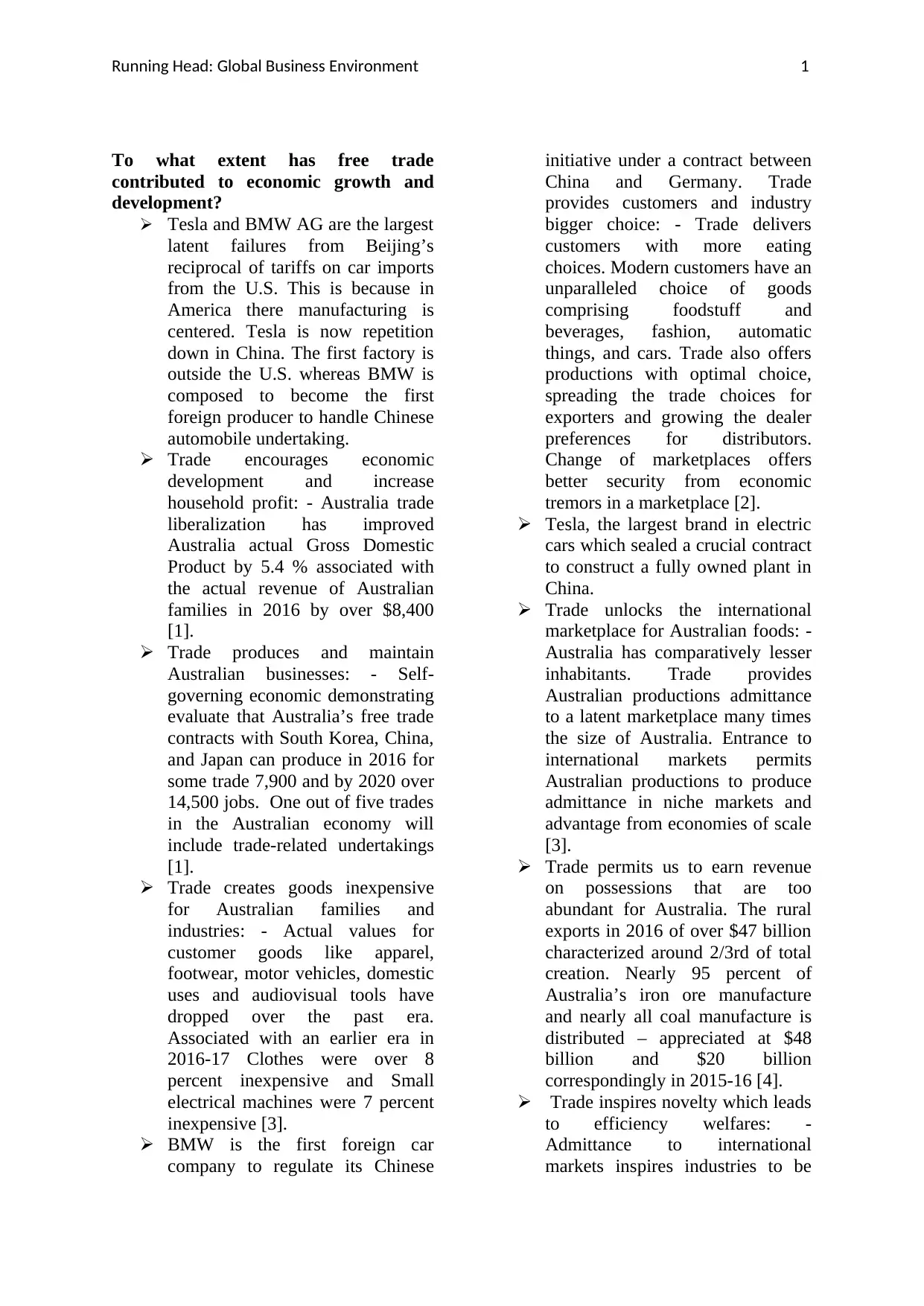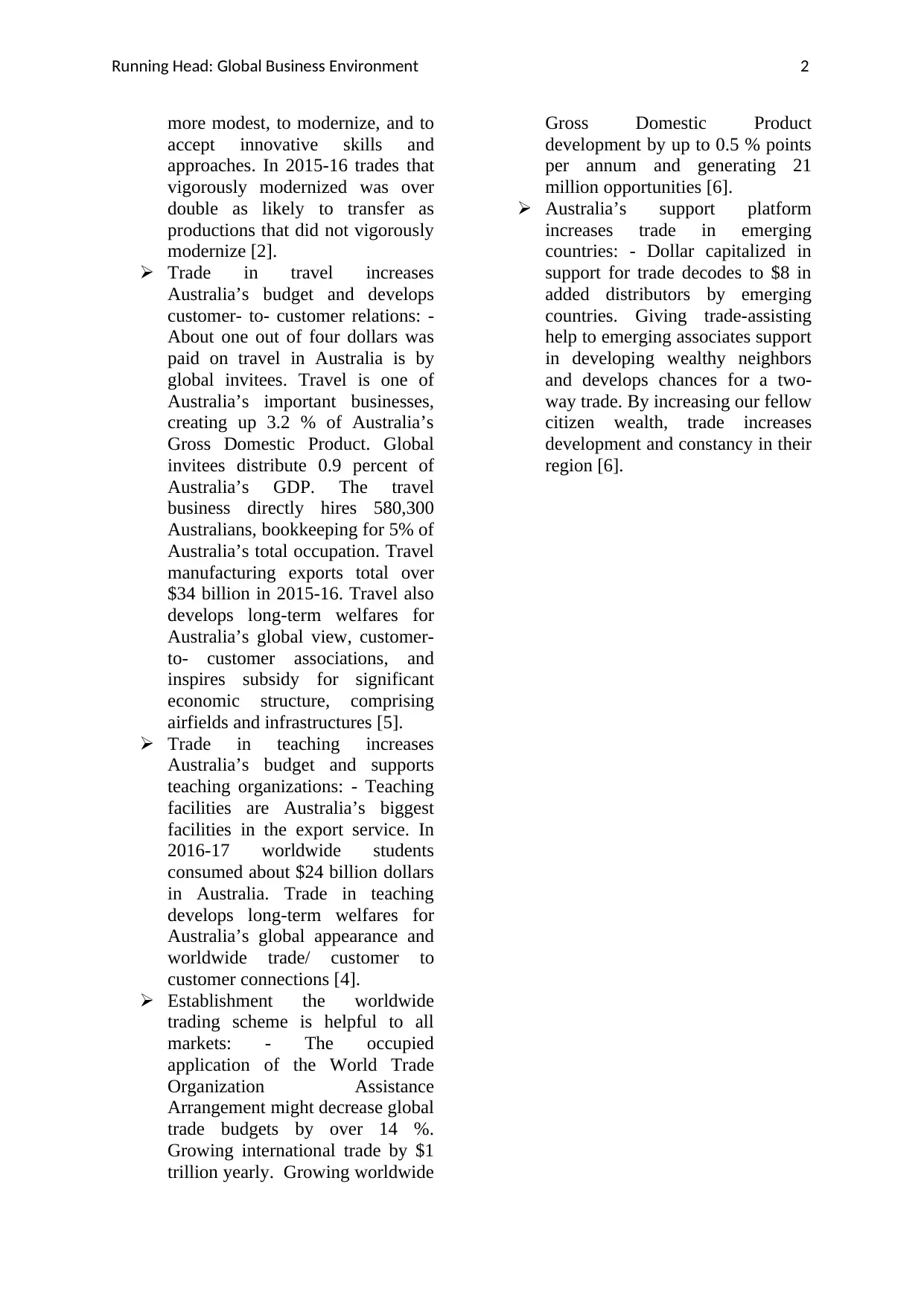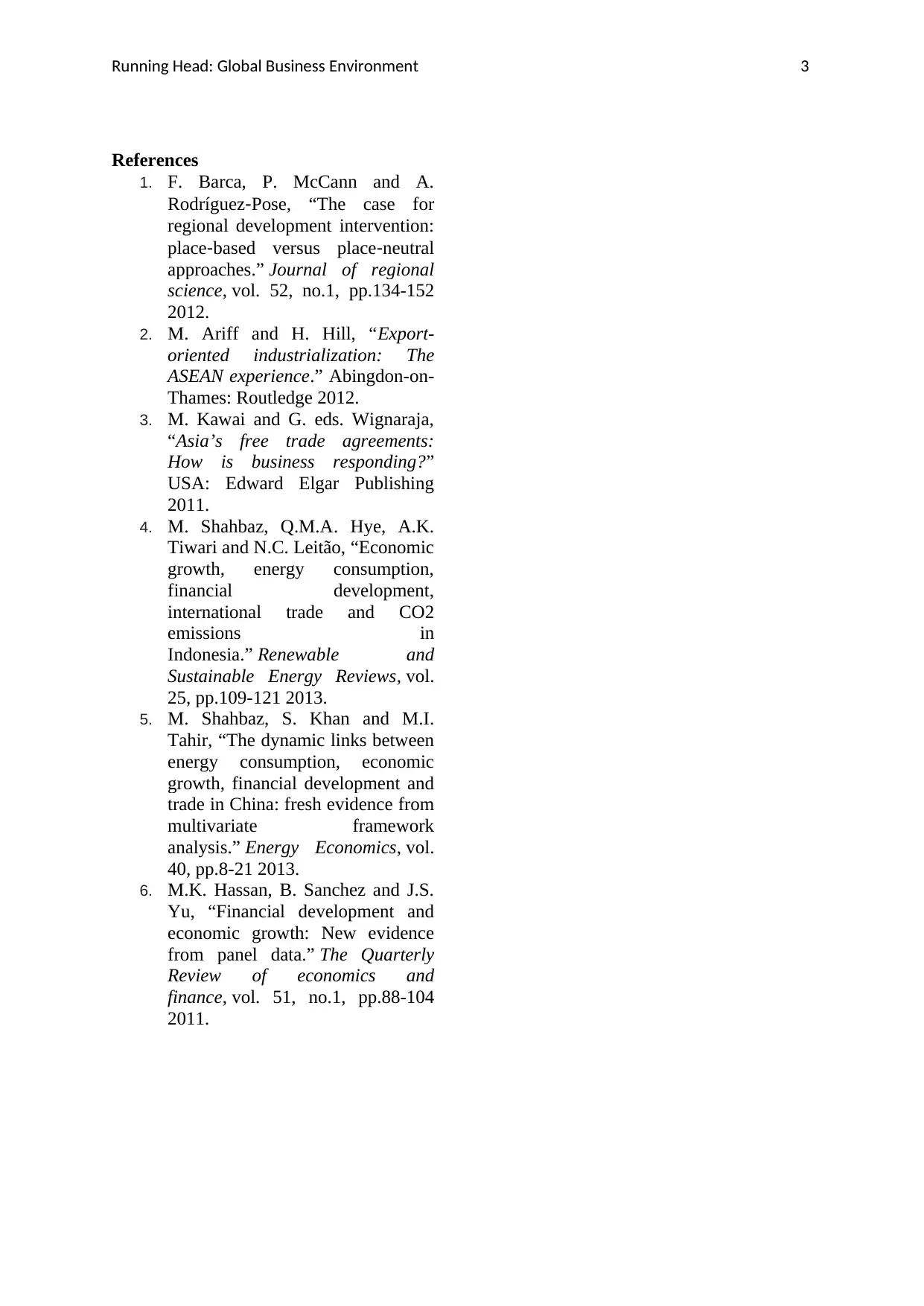The Role of Free Trade in Economic Growth and Development
VerifiedAdded on 2023/06/08
|4
|1124
|302
AI Summary
This article explores the impact of free trade on economic growth and development, with a focus on Australia and China. It covers topics such as job creation, increased household income, and access to international markets. The article also discusses the role of trade in supporting industries, inspiring innovation, and promoting customer choice. Additionally, it highlights the benefits of trade in travel and education, and the potential for a global trading system to benefit all markets.
Contribute Materials
Your contribution can guide someone’s learning journey. Share your
documents today.

Running Head: Global Business Environment 0
Global Business Environment
8/29/2018
Global Business Environment
8/29/2018
Secure Best Marks with AI Grader
Need help grading? Try our AI Grader for instant feedback on your assignments.

Running Head: Global Business Environment 1
To what extent has free trade
contributed to economic growth and
development?
Tesla and BMW AG are the largest
latent failures from Beijing’s
reciprocal of tariffs on car imports
from the U.S. This is because in
America there manufacturing is
centered. Tesla is now repetition
down in China. The first factory is
outside the U.S. whereas BMW is
composed to become the first
foreign producer to handle Chinese
automobile undertaking.
Trade encourages economic
development and increase
household profit: - Australia trade
liberalization has improved
Australia actual Gross Domestic
Product by 5.4 % associated with
the actual revenue of Australian
families in 2016 by over $8,400
[1].
Trade produces and maintain
Australian businesses: - Self-
governing economic demonstrating
evaluate that Australia’s free trade
contracts with South Korea, China,
and Japan can produce in 2016 for
some trade 7,900 and by 2020 over
14,500 jobs. One out of five trades
in the Australian economy will
include trade-related undertakings
[1].
Trade creates goods inexpensive
for Australian families and
industries: - Actual values for
customer goods like apparel,
footwear, motor vehicles, domestic
uses and audiovisual tools have
dropped over the past era.
Associated with an earlier era in
2016-17 Clothes were over 8
percent inexpensive and Small
electrical machines were 7 percent
inexpensive [3].
BMW is the first foreign car
company to regulate its Chinese
initiative under a contract between
China and Germany. Trade
provides customers and industry
bigger choice: - Trade delivers
customers with more eating
choices. Modern customers have an
unparalleled choice of goods
comprising foodstuff and
beverages, fashion, automatic
things, and cars. Trade also offers
productions with optimal choice,
spreading the trade choices for
exporters and growing the dealer
preferences for distributors.
Change of marketplaces offers
better security from economic
tremors in a marketplace [2].
Tesla, the largest brand in electric
cars which sealed a crucial contract
to construct a fully owned plant in
China.
Trade unlocks the international
marketplace for Australian foods: -
Australia has comparatively lesser
inhabitants. Trade provides
Australian productions admittance
to a latent marketplace many times
the size of Australia. Entrance to
international markets permits
Australian productions to produce
admittance in niche markets and
advantage from economies of scale
[3].
Trade permits us to earn revenue
on possessions that are too
abundant for Australia. The rural
exports in 2016 of over $47 billion
characterized around 2/3rd of total
creation. Nearly 95 percent of
Australia’s iron ore manufacture
and nearly all coal manufacture is
distributed – appreciated at $48
billion and $20 billion
correspondingly in 2015-16 [4].
Trade inspires novelty which leads
to efficiency welfares: -
Admittance to international
markets inspires industries to be
To what extent has free trade
contributed to economic growth and
development?
Tesla and BMW AG are the largest
latent failures from Beijing’s
reciprocal of tariffs on car imports
from the U.S. This is because in
America there manufacturing is
centered. Tesla is now repetition
down in China. The first factory is
outside the U.S. whereas BMW is
composed to become the first
foreign producer to handle Chinese
automobile undertaking.
Trade encourages economic
development and increase
household profit: - Australia trade
liberalization has improved
Australia actual Gross Domestic
Product by 5.4 % associated with
the actual revenue of Australian
families in 2016 by over $8,400
[1].
Trade produces and maintain
Australian businesses: - Self-
governing economic demonstrating
evaluate that Australia’s free trade
contracts with South Korea, China,
and Japan can produce in 2016 for
some trade 7,900 and by 2020 over
14,500 jobs. One out of five trades
in the Australian economy will
include trade-related undertakings
[1].
Trade creates goods inexpensive
for Australian families and
industries: - Actual values for
customer goods like apparel,
footwear, motor vehicles, domestic
uses and audiovisual tools have
dropped over the past era.
Associated with an earlier era in
2016-17 Clothes were over 8
percent inexpensive and Small
electrical machines were 7 percent
inexpensive [3].
BMW is the first foreign car
company to regulate its Chinese
initiative under a contract between
China and Germany. Trade
provides customers and industry
bigger choice: - Trade delivers
customers with more eating
choices. Modern customers have an
unparalleled choice of goods
comprising foodstuff and
beverages, fashion, automatic
things, and cars. Trade also offers
productions with optimal choice,
spreading the trade choices for
exporters and growing the dealer
preferences for distributors.
Change of marketplaces offers
better security from economic
tremors in a marketplace [2].
Tesla, the largest brand in electric
cars which sealed a crucial contract
to construct a fully owned plant in
China.
Trade unlocks the international
marketplace for Australian foods: -
Australia has comparatively lesser
inhabitants. Trade provides
Australian productions admittance
to a latent marketplace many times
the size of Australia. Entrance to
international markets permits
Australian productions to produce
admittance in niche markets and
advantage from economies of scale
[3].
Trade permits us to earn revenue
on possessions that are too
abundant for Australia. The rural
exports in 2016 of over $47 billion
characterized around 2/3rd of total
creation. Nearly 95 percent of
Australia’s iron ore manufacture
and nearly all coal manufacture is
distributed – appreciated at $48
billion and $20 billion
correspondingly in 2015-16 [4].
Trade inspires novelty which leads
to efficiency welfares: -
Admittance to international
markets inspires industries to be

Running Head: Global Business Environment 2
more modest, to modernize, and to
accept innovative skills and
approaches. In 2015-16 trades that
vigorously modernized was over
double as likely to transfer as
productions that did not vigorously
modernize [2].
Trade in travel increases
Australia’s budget and develops
customer- to- customer relations: -
About one out of four dollars was
paid on travel in Australia is by
global invitees. Travel is one of
Australia’s important businesses,
creating up 3.2 % of Australia’s
Gross Domestic Product. Global
invitees distribute 0.9 percent of
Australia’s GDP. The travel
business directly hires 580,300
Australians, bookkeeping for 5% of
Australia’s total occupation. Travel
manufacturing exports total over
$34 billion in 2015-16. Travel also
develops long-term welfares for
Australia’s global view, customer-
to- customer associations, and
inspires subsidy for significant
economic structure, comprising
airfields and infrastructures [5].
Trade in teaching increases
Australia’s budget and supports
teaching organizations: - Teaching
facilities are Australia’s biggest
facilities in the export service. In
2016-17 worldwide students
consumed about $24 billion dollars
in Australia. Trade in teaching
develops long-term welfares for
Australia’s global appearance and
worldwide trade/ customer to
customer connections [4].
Establishment the worldwide
trading scheme is helpful to all
markets: - The occupied
application of the World Trade
Organization Assistance
Arrangement might decrease global
trade budgets by over 14 %.
Growing international trade by $1
trillion yearly. Growing worldwide
Gross Domestic Product
development by up to 0.5 % points
per annum and generating 21
million opportunities [6].
Australia’s support platform
increases trade in emerging
countries: - Dollar capitalized in
support for trade decodes to $8 in
added distributors by emerging
countries. Giving trade-assisting
help to emerging associates support
in developing wealthy neighbors
and develops chances for a two-
way trade. By increasing our fellow
citizen wealth, trade increases
development and constancy in their
region [6].
more modest, to modernize, and to
accept innovative skills and
approaches. In 2015-16 trades that
vigorously modernized was over
double as likely to transfer as
productions that did not vigorously
modernize [2].
Trade in travel increases
Australia’s budget and develops
customer- to- customer relations: -
About one out of four dollars was
paid on travel in Australia is by
global invitees. Travel is one of
Australia’s important businesses,
creating up 3.2 % of Australia’s
Gross Domestic Product. Global
invitees distribute 0.9 percent of
Australia’s GDP. The travel
business directly hires 580,300
Australians, bookkeeping for 5% of
Australia’s total occupation. Travel
manufacturing exports total over
$34 billion in 2015-16. Travel also
develops long-term welfares for
Australia’s global view, customer-
to- customer associations, and
inspires subsidy for significant
economic structure, comprising
airfields and infrastructures [5].
Trade in teaching increases
Australia’s budget and supports
teaching organizations: - Teaching
facilities are Australia’s biggest
facilities in the export service. In
2016-17 worldwide students
consumed about $24 billion dollars
in Australia. Trade in teaching
develops long-term welfares for
Australia’s global appearance and
worldwide trade/ customer to
customer connections [4].
Establishment the worldwide
trading scheme is helpful to all
markets: - The occupied
application of the World Trade
Organization Assistance
Arrangement might decrease global
trade budgets by over 14 %.
Growing international trade by $1
trillion yearly. Growing worldwide
Gross Domestic Product
development by up to 0.5 % points
per annum and generating 21
million opportunities [6].
Australia’s support platform
increases trade in emerging
countries: - Dollar capitalized in
support for trade decodes to $8 in
added distributors by emerging
countries. Giving trade-assisting
help to emerging associates support
in developing wealthy neighbors
and develops chances for a two-
way trade. By increasing our fellow
citizen wealth, trade increases
development and constancy in their
region [6].

Running Head: Global Business Environment 3
References
1. F. Barca, P. McCann and A.
Rodríguez‐Pose, “The case for
regional development intervention:
place‐based versus place‐neutral
approaches.” Journal of regional
science, vol. 52, no.1, pp.134-152
2012.
2. M. Ariff and H. Hill, “Export-
oriented industrialization: The
ASEAN experience.” Abingdon-on-
Thames: Routledge 2012.
3. M. Kawai and G. eds. Wignaraja,
“Asia’s free trade agreements:
How is business responding?”
USA: Edward Elgar Publishing
2011.
4. M. Shahbaz, Q.M.A. Hye, A.K.
Tiwari and N.C. Leitão, “Economic
growth, energy consumption,
financial development,
international trade and CO2
emissions in
Indonesia.” Renewable and
Sustainable Energy Reviews, vol.
25, pp.109-121 2013.
5. M. Shahbaz, S. Khan and M.I.
Tahir, “The dynamic links between
energy consumption, economic
growth, financial development and
trade in China: fresh evidence from
multivariate framework
analysis.” Energy Economics, vol.
40, pp.8-21 2013.
6. M.K. Hassan, B. Sanchez and J.S.
Yu, “Financial development and
economic growth: New evidence
from panel data.” The Quarterly
Review of economics and
finance, vol. 51, no.1, pp.88-104
2011.
References
1. F. Barca, P. McCann and A.
Rodríguez‐Pose, “The case for
regional development intervention:
place‐based versus place‐neutral
approaches.” Journal of regional
science, vol. 52, no.1, pp.134-152
2012.
2. M. Ariff and H. Hill, “Export-
oriented industrialization: The
ASEAN experience.” Abingdon-on-
Thames: Routledge 2012.
3. M. Kawai and G. eds. Wignaraja,
“Asia’s free trade agreements:
How is business responding?”
USA: Edward Elgar Publishing
2011.
4. M. Shahbaz, Q.M.A. Hye, A.K.
Tiwari and N.C. Leitão, “Economic
growth, energy consumption,
financial development,
international trade and CO2
emissions in
Indonesia.” Renewable and
Sustainable Energy Reviews, vol.
25, pp.109-121 2013.
5. M. Shahbaz, S. Khan and M.I.
Tahir, “The dynamic links between
energy consumption, economic
growth, financial development and
trade in China: fresh evidence from
multivariate framework
analysis.” Energy Economics, vol.
40, pp.8-21 2013.
6. M.K. Hassan, B. Sanchez and J.S.
Yu, “Financial development and
economic growth: New evidence
from panel data.” The Quarterly
Review of economics and
finance, vol. 51, no.1, pp.88-104
2011.
1 out of 4
Your All-in-One AI-Powered Toolkit for Academic Success.
+13062052269
info@desklib.com
Available 24*7 on WhatsApp / Email
![[object Object]](/_next/static/media/star-bottom.7253800d.svg)
Unlock your academic potential
© 2024 | Zucol Services PVT LTD | All rights reserved.
